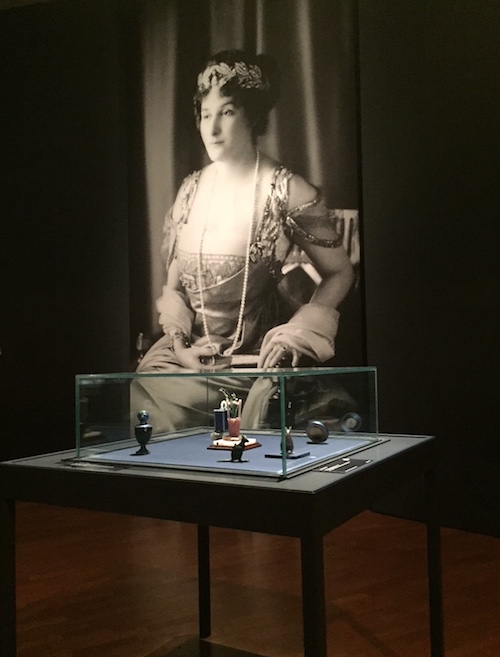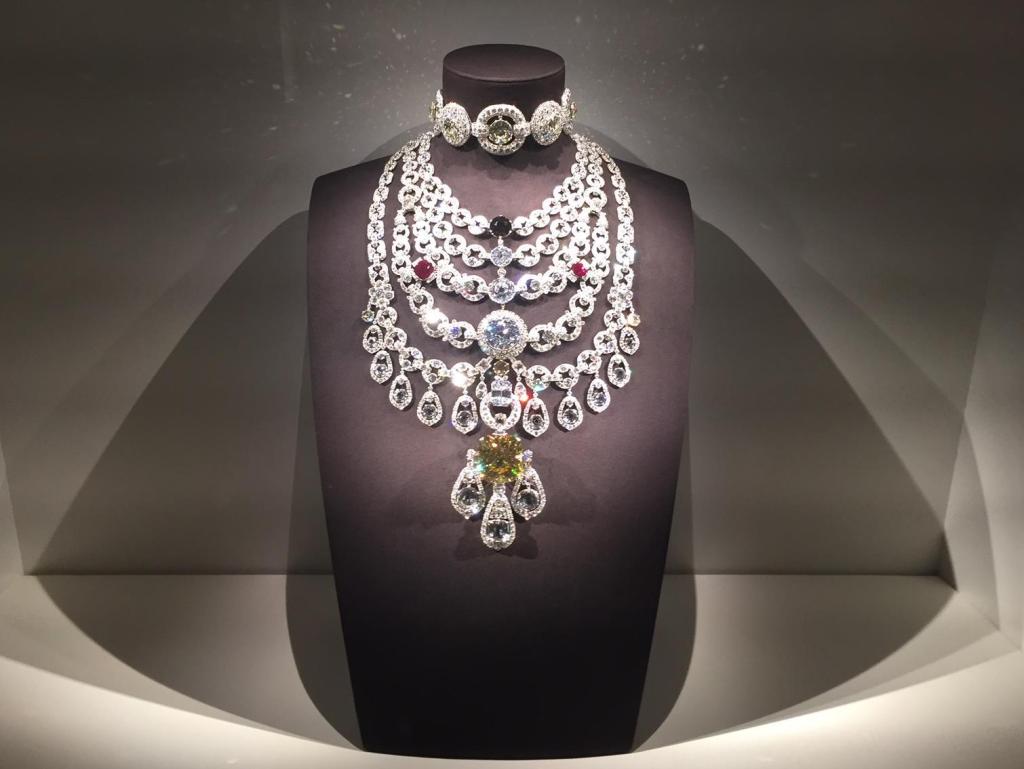Cartier Paris, Necklace (1928) special order by Maharaja Bhupinder Singh of Patialia, India; platinum, old and rose cut diamonds, cushion shaped yellow zirconia, white zirconia, white topaxes, synthetic rubies, smoky quartz, citrine; Cartier Collection. Lost during the 1940s, many of the largest stones were removed, and while restoring it Cartier has used synthetic stones until perfect replacements can be found.
Walking into Cartier: The Exhibition, one of the first objects that visitors see is a pair of kangaroos from 1905 – one made of gray agate and the other nephrite adorned with rose-cut diamonds. They are discretely displayed in a museum case before a backdrop depicting Princess Marie Bonaparte, the heiress and great-niece of France’s Emperor Napoleon 1 and wife of Prince George of Greece, in all her bejeweled spendour. Her wedding tiara, a bejeweled wreath from 1907, is displayed in an adjacent cabinet.
The pairing, while somewhat bizarre, sums up this exhibition in many ways – big name bling alongside subtle and surprising discoveries. Created just two years apart, these objects – tiara and kangaroos – speak of great histories, of nations, their aspirations, and objects as symbols of national vision or moment. The kangaroos from a newly federated Australia branding its unique position in the world, while Bonaparte’s tiara in the garland-style – Cartier’s first signature product – is inspired by Louise XVI’s French court styles with its allusions to antiquity.
Simply, Cartier The Exhibition is unexpected – a reaction I totally did not expect.

Installation view, Cartier: The Exhibition, with portrait of Princess Marie Bonaparte and Australian objects; photo ArtsHub
We all expected this exhibition to bring case after case of big rocks from one of the world’s most iconic houses – complete with hovering security guards – but it is history that is the other giant on display here, alongside the brand.
As Pascale Lepeu, Curator of the Cartier Collection, said to ArtsHub: ‘When you go through the exhibition it is beyond Cartier, it is more about the history of the 20th century.’
Cartier has been buying back that history since 1983, when it formed the Cartier Collection, along with rare archival material, which is also on show. An object that caught my eye was the travel notebook documenting Jacques Cartier’s first trip to India in 1911, and those of his staff visits to Persia in 1908.
Lepeu added: ‘It was a pioneering decision to collect. Cartier has always been ahead of things. There are very few jewelry collections in museums as most jewels are kept in families. And when the Collection had its first exhibition in Paris in 1989 hundreds of thousands of visitors came – it was the start of something.’
That something is continued in Canberra with over 300 objects on display at the National Gallery of Australia (NGA).
Director Gerard Vaughan said that Cartier and the NGA have worked together for several years on this exclusive exhibition. ‘There are things shown here that have never been exhibited before. I like to describe as a kind of immersion into a world of glamour and style.’
Installation view with Dame Nellie Melba collection in the rear and Ballet Russes in front.
More than bling in boxes
Australia is given a nod again early in the show with a section dedicated to opera singer Dame Nellie Melba. Theatre accouterments, along with a diamond necklace fit for a diva, are presented with a marble bust, a portrait of Melba and a dress worn by her, loaned from the Arts Centre Melbourne Collection. It is a nice way to add texture to this exhibition, and gives context for viewers wishing to stitch threads of reality across this show.
In the same room is the Ballet Russes’ costume for Shah Zeman, paired with a 478 carat sapphire pendant from 1913 inspired by the orientalist production Scheherazade, the storyteller in One Thousand and One Nights. It is not often one gets to see triple digit carat gems up close and personal, but in this exhibition you can take your pick of them, from emeralds and diamonds to rubies.
Pendant (1913) Cartier Paris, platinum, sapphire, diamonds; Collection Qatar Museums
The exhibition then journeys through India, the Islamic world, Egypt and Asia before eventually arriving at Royalty, then Hollywood.
Internationally-renowned scenographer Nathalie Criniere was responsible for the exhibition design – and it is just as mind-blowing as the objects on show. Well, maybe I’m a bit of a museum geek, but the attention to historical punctuation, themes, spirit and energy across this exhibition is beautifully expressed.
For example, a space presenting works from the Art Deco era uses mirrors, black glass and a stylized freize; another room is painted blue to pick up the jewels inspired by Egyptian antiquities, and a red carpet ushers viewers through a section exploring Hollywood celebrity.
I dwell on this because, again, it demonstrates that Cartier: The Exhibition is far more than just expensive jewels on show. There is a sense of journey, as historic punctuations are played out with colour, as rooms change tone with various themes, and geographic fascinations filter their way into Cartier designs.
While it might be the tiara loaned to Catherine Middleton on her wedding day by Her Majesty The Queen or Grace Kelly’s engagement ring, the famous Indian Tiara owned by The Duchess of Gloucester, or Elizabeth Taylor’s ruby and diamond necklace that captures the attention of popular media and draws in the crowds, it is these other aspects of this exhibition, in my opinion, that are the real gems.
The story I like best is that of the vanity case, which came to epitomise not just the excesses of the the Roaring 20’s and the interwar years, but the growing independence and emancipation of women. The fashionable woman could now smoke, apply lipstick and powder her nose in public, and these precious objects captured this era in succinct and dazzling style – a miniature that revealed the zeitgeist of an Age of Glamour.
The exhibition reaches its conclusion with the Golden Age of Hollywood. A nice inclusion is a montage of all the great lines in films that expound the mythology that “diamonds are a girl’s best friend”.
The closing message of this exhibition is one of glamour. I probed Pascale Lepeu whether, for her, this exhibition was perhaps the start to bringing glamour back? And had our attitudes towards jewellery changed so much that these objects have little other use than museum pleasers?
‘Jewels are made to be worn,’ Lepeu answered emphatically. ‘There is this idea of transmission – if you buy a Cartier you will always remember when you bought it or who bought it for you. People still wear jewels – maybe it is less than Gloria Swanson and maybe you don’t see as much in the streets, but people still wear jewellery and it still has the same messages inside it – very often it is love and friendship, family.’
I often wonder where glamour has gone in this, our 21st century, where teenagers dress like sex workers and our role models for glamour are Kardashians and Real Housewives. What happened to style, grace, romance and mystery?
While we can’t all afford Cartier – or may not have the inclination to wear jewellery, regardless of the brand – this exhibition is a reminder that we have in some way lost something at our own hand. And in that, maybe it offers a moment of recalibration.
As Lepeu concluded: ‘We like to think of Cartier as an evolution; Cartier has always been part of its time.’ Let’s take Cartier’s cue. Today we embrace sameness because its easy. This exhibition celebrates individuality, confidence, personal expression and craftsmanship. So, if for no other reason than that, Cartier: The Exhibition is a must see – a wake up call.
Cartier: The Exhibition opens on Good Friday.
★★★★★
Cartier: The Exhibition
National Gallery of Australia, Canberra
30 March until 22 July 2018
Co-curated by Margaret Young-Sánchez, formerly Chief Curator of Denver Art Museum and Simeran Maxwell, NGA Curator of International Art







